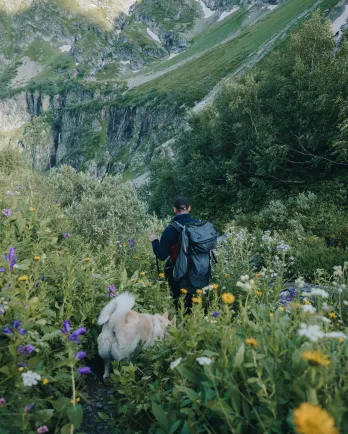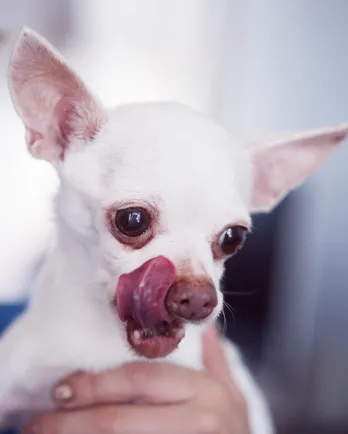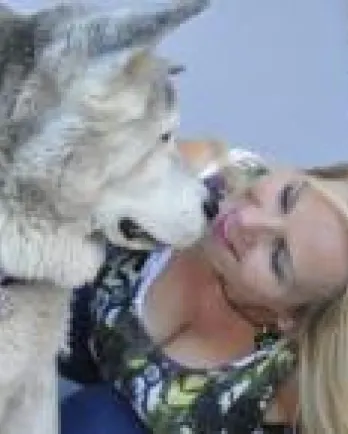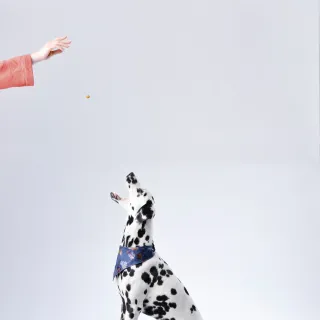Tips to Help Your Senior Dog Live a Longer, Happier Life
By Denise Fleck
[Some portions excerpted from her book, The Autumn & Winter of Your Pet: Make Those Senior Years Golden]
As much as we’d like, we can’t turn back the paws of time, so there are some things we just can’t change about our senior dogs:
ANCESTRY: We can’t change DNA (well, not yet), so your dog may be susceptible to certain diseases and defects based on his or her canine parents’ genes. For example, if your doggie’s daddy or a sibling suffered from Bloat, your dog is more likely to as well.
BREED SPECIFIC HEALTH CONDITIONS
- Bichon Frises, Border Terriers and Cocker Spaniels are prone to cataracts while a different eye disease, Entropion, is more common in Sharpeis.
- Dachshunds and Basset Hounds are at risk for spinal injuries while most working and herding breeds are more likely to experience Hip Dysplasia or Cruciate Ligament Ruptures to their knee joints.
- Doberman Pinschers, Setters, Rottweilers are most inclined to get Von Willebrand Disease, where blood has difficulty clotting.
The American Kennel Club’s Canine Health Foundation has a more complete list to help you learn about which conditions your canine best pal is predisposed to. None of these conditions are guaranteed to occur, but it’s helpful to know what your breed is most at risk for and maybe then you can find ways to prevent or manage it.
CALENDAR: The typical life span for a breed and size places giant breeds at 6-8 years with medium to large breeds making it to 10-12 years of age. Small dog breeds often thrive well into their late teens.
Besides what parents and breed gave your pooch, like a person, sometimes a dog is born with parts that just don’t come out the way nature intended, or did they? Animals don’t realize that we were meant to be any different than they are, so they accept and live life without the mental baggage that causes us humans stress however, after years of use, some parts may present problems to your pet.
Remember, aging is not a disease…it’s a process we all go through. It shows we’re growing old and living life. Nothing was meant to last forever (except your love for your dog and his for you). The point is to walk every path, sniff every scent and enjoy the journey together.
The GRReat news is that YOU CAN MAKE A DIFFERENCE in how long your senior dog gets to remain by your side by managing how you spend your time together, what he eats, and the trouble he gets into. Unlike breed and family history, some of the Grey Muzzle board, staff and advisory team have put together a list of things YOU can change to help Fido or Fifi live a longer, happier, healthier life with you:
EXERCISE
- Stretch those legs daily to circulate blood and oxygen and keep joints flexible. Cold and wet weather may make aging joints ache, but daily exercise is a must, so supervise your pooch on a doggie treadmill, romp indoors chasing a ping pong ball or do laps at the local pet or hardware store to keep those legs warm and moving when weather isn’t the best.
Engaging in physical activity together is an important component of the human-animal bond. Humans and dogs are the only two species that interrelate this way. Dogs and people were designed to walk, run, and play side by side. Ernie Ward, DVM
Grey Muzzle’s Communications Director, Abby Ouimet, can attest to the importance of that time spent together, “When my two doggos were in their golden years, I specifically asked our vet if I should limit their exercise? He looked at me and said, ‘Why?’ I said, ‘Because they're getting older,’ and he said, ‘Well, that's true and you might have to go slower, but as long as they're enjoying themselves, you should keep their exercise routine the same and let them set the pace.’ So that's what I did! We live in a beautiful place with trails behind our house and it was always such a joyful time in the morning and at sunset to walk with them in the woods. I'm glad I didn't just decide for them to limit or change their exercise, but listened to my vet and let my dogs tell me what they wanted.”
Grey Muzzle’s Secretary and Board Member, Katie Parker, concurs, “Senior dogs still need exercise, but they need good rest too. Make sure you help your senior pup, especially those active seniors, pace their amount and level of exertion.”
TRAINING & MENTAL HEALTH
Keep your senior dog mentally and physically strong throughout his life. We all need reminders of our manners and tricks we learned long before:
- may keep your dog out from danger.
- Leave it! will prevent him from eating that gooey, smelly oh-so-tempting puddle on the floor that could be toxic!
- is polite and allows you to put on your dog’s leash or wait for a treat.
- keeps him from running into the path of a car.
- is like a game of follow-the-leader keeping your best pal by your side.
Then there are puzzle games, a virtual hide and seek for treats and always a new and improved pet product to keep your eyes tuned to. Also, take your dog to new places, journey backwards on your typical walk, mix it up and help your pet sniff new smells, see new things and engage all his senses.
Don’t think of your senior dog as tired and old but instead as a pal in retirement. He still has good years ahead of him and can enjoy walks, fun but low-impact activities such as swimming and nose work, and toys that challenge his brain, keeping it sharp. America’s Veterinarian, Dr. Marty Becker
NUTRITION
What you put in your senior dog is what you will get out of him, literally! Read labels looking for high quality proteins, items you can pronounce and limited to no fillers, but also talk to your veterinarian or canine nutritionist to feed what is best for your one-of-a-kind dog. Even dogs from the same litter, may not thrive on the same diet. The best food for your pet is the food he does best on.
Know that some foods you enjoy are actually poisonous to dogs: grapes, raisins, chocolate, certain nuts, xylitol and many more items in your pantry and medicine cabinet. The Pet Poison Helpline is a good resource to make sure you keep dangers out of paws reach.
Keeping a dog lean has been shown to be able to extend its life and quality of life, hopefully avoiding or minimizing issues such as osteoarthritis and even diabetes. Heidi Lobprise, DVM, DAVDC
Don’t mistake treats for love. Shower your older fella or lady with belly rubs, ear scratches and time spent with you. Keep snacking to a minimum for the sake of his waistline, joints, heart and kidneys.
If your pet’s sense of smell is waning or he needs a bit of encouragement to dine, warm up the food ever so gently or add smelly but wondeRUFFully healthy Omega 3 fish oils to wake up his olfactory senses. Grey Muzzle’s Vice President, Jessica Rothfuss, says, “Sometimes a little water in the food can entice an unwilling senior to eat.” It just might soften that kibble making it more palatable for those tender gums and missing teeth.
TUNE IN TO YOUR SENIOR DOG
One of the most beneficial things you can do regularly for your senior pooch is to give him a weekly Head-to-Tail check-up. Gently feel from the tip of his ears down to the end of that waggly tail checking for lumps, bumps, parasites, burrs – anything that shouldn’t be there. Catching a problem early and reporting it to your veterinarian could be a life-saver!
Explains Grey Muzzle’s Past President and current Board Member Jenny Kachnic, “Any change in appetite, bowel movements, behavior, anything can be a sign of a potential problem in your senior dog.”
ANNUAL / BI-ANNUAL VETERINARY CHECK-UPS
One of the best ways to insure your dog has a healthy senior-hood is to make sure he stays fit and strong in his early years. Annual visits keep Fido at his peak and ward off possible disease through vaccinations and early detection. Spaying or neutering can lower risks of certain cancers, prostate infections and pyometra – a serious infection of the uterus.
Hopefully your pal will come to enjoy your weekly head-to-tail checks at home, but there is nothing like the professional eyes, ears, hands, stethoscope, blood test and urinalysis he get from his second best friend (aka his veterinarian) that can find something happening inside before you ever suspect something’s not quite right.
A dog can have up to 75 percent loss of kidney function and still appear just fine on the surface. Schedule lab tests twice a year for golden oldies to keep tabs on their internal functioning and catch problems early, when they are more manageable.
If your aging dog is stiff from arthritis, know that he doesn’t have to limp around or be painful. Your veterinarian can prescribe a combo of medications and supplements that will put a spring back in his step and help him sleep more restfully. And if he's overweight, helping him shed a few pounds is the best thing you can do to relieve stress on achy joints. --America’s Veterinarian, Dr. Marty Becker
Everything in the canine body is accelerated from Day One! Your dog goes from no teeth to having ALL his baby teeth by Day 45. It takes humans 4-7 months for that first set of choppers to come in.
At 6 months of age, most breeds are adults and can be sexually active (not that they should, mind you, but all the parts start working). Should a female conceive, her puppy is in the womb approximately 63 days (aka gestation period). It takes a human baby 9 months to develop before birth.
All of this expedited growth hastens the canine aging process. Dogs work harder to maintain their 101°F body temperature (in part because they possess fewer sweat glands), and their metabolism burns calories twice as fast as ours does. Sadly, their candle burns out more quickly, so we must stay on top of their health and well-being.
As pets age, they need more frequent medical examinations and diagnostic work-ups such as blood work, urinalysis, blood pressure measurement and even x-rays to detect early signs of disease. Most dogs are not ‘too old for a dental’; as long as they are relatively low risk with underlying diseases stabilized, good dental care can greatly improve not just the quality, but possibly even the ‘quantity’ of life. --Heidi Lobprise, DVM, DAVDC
And keep in mind that if your formerly sweet doggy has been a bit on the grouchy side lately, it may be due to a medical issue, so get him checked out. Pain can make anyone cranky and more prone to snap!
TLC
Never lose patience with your loyal best friend. As your dog ages, he may feel the urge to answer nature’s call more frequently and may not be able to let you know quick enough. Help him by increasing the frequency of potty breaks, install a doggie door to a securely fenced yard, line bedding with plastic to make for easy clean-up. Make your life simpler, as well as your dog’s. so that you can return that unconditional love and put any frustrations to rest.
Using runners on slick floors can really help an older dog get around better. Some even benefit from ‘toe grips’ placed on the nails that help provide better traction. --Heidi Lobprise, DVM, DAVDC
Consider doggie steps to allow your senior to still curl up on the bed or sofa next to you. If there’s a special window he enjoys watching the mailman from, maybe a hassock or other cushion could be placed to allow his fun to continue.
Depending on the ailment, warm or cool may serve your dog best. Grey Muzzle’s Administrative Assistant, Amanda Grant shares, “One thing our vet told us to do for our dog that he loved, was use a heating pad under a blanket on his bed. He had arthritic joints, so laying on the heating pad (low setting, of course, and no direct contact) really helped to comfort him and ease pain.”
For others…
Keep the house cool at night. Seniors often get a heat spike between one and three am. Keeping the house cool can reduce night-waking. Kathleen Cooney, DVM, MS, CHPV
QUALITY TIME SPENT WITH YOU
You are, after all, your dog’s favorite person and spending time together is why you share this life in the first place. Really make time for quality time each and every day. That precious soul waits anxiously for you to come home. Don’t drop your bags, pat him on the head and go onto other things. Don’t talk or text when you are out on walks, and when he can’t be on the go as much, sit quietly together gazing at the clouds or stars and chose a special one that is yours and your dog’s alone that you’ll remember when he’s no longer by your side.
When the end is near, in-home hospice care can be a blessing to the pet and family. Individual veterinary clinics and groups (Lap of Love Hospice Care) can help with supportive care. --Heidi Lobprise, DVM, DAVDC
Known as The Pet Safety Crusader™, Denise has personally taught more than 15,000 humans animal life-saving skills and has appeared on Animal Planet’s Groomer Has It and Pit Boss, A&E’s Kirstie Alley’s Big Life, CBS-TV’s The Doctors, CNN Headline News, PBS-TV’s Lassie’s Pet Vet and KTLA Los Angeles as well as on radio and in magazines.
She is currently the President of Grey Muzzle's Board of Directors. You can read more about her here.





